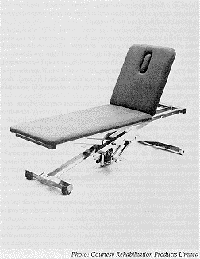Most patients consulting osteopathic practitioners will do so in the hope of obtaining relief from musculo-skeletal aches and pains. In the main, the low back and neck are the areas most likely to be involved, but all the joints and muscles of the body are possible sources of problems which may be helped by osteopathic care. A growing number of patients, however, do consult osteopaths about a wider range of health problems, and these might include such conditions as migraine headaches, tinnitus (noises in the head), dizziness, bronchial problems, asthma, functional cardiac problems, digestive problems and menstrual irregularities. The treating of these and other conditions by osteopathic methods can be surprisingly successful.

Photo: Courtesy Rehabilitation Products Limited.
An osteopathic treatment couch.
What Happens On Visiting an Osteopath
A typical visit to an osteopath can last from fifteen to forty-five minutes, depending upon the condition, and at the first visit the osteopath will take a case history and conduct a detailed examination and assessment of the spinal and other joints. Should the condition warrant it, x-ray pictures might be taken. In many cases the heart and chest will be examined, blood pressure taken and possibly other clinical tests performed or arranged (urine tests, blood tests, eye or ear assessments etc.) In these ways the osteopath arrives at a diagnosis as to the causes of the patient's problems, or at least as to the possible musculo-skeletal involvement in whatever problem the patient is troubled with.
Treatment normally consists of preliminary soft-tissue manipulation. This might be local to the area of pain, or distant from it if the osteopath is attempting to influence the condition reflexly. Having stretched, relaxed and generally prepared the soft tissues, the osteopath will manipulate the appropriate joint or joints. As shown in Chapter 6, a variety of methods may be used at this stage. The age, condition, degree of pain and spasm etc. will all decide which is the most desirable approach.
Some forms of manipulation produce an audible snapping or popping sound. This is thought to result from the creation of a momentary vacuum between the joint surfaces as they are manipulated. Such sounds do not necessarily indicate that the manipulation has been successful, nor does the absence of such sounds mean that the treatment has failed to achieve mobility.
After treatment there is often immediate relief from pain and improved mobility. However, there may be a degree of transient discomfort, and in some cases a slight increase in pain may be felt for a day or so, especially in acute conditions. More usually there is a feeling of well-being. Some patients experience a marked degree of relaxation and a desire to sleep, and others feel a sense of exhilaration and energy.
Practitioners will explain the objectives of the treatment, and may well suggest a programme of home treatment to augment and support the osteopathic therapy. This could include exercise, dietary changes and relaxation. If the condition is a simple mechanical strain, then it would normally be correctable fairly quickly, and require no further attention. If, on the other hand, the condition is of a more chronic nature, then periodic maintenance treatment may be necessary to prevent a recurrence.
The frequency of osteopathic treatment can vary from very often, say every other day, to occasional, say every month or so. In chronic conditions the regular ‘maintenance' treatment is likely to be at intervals of anything from once weekly to once in three or four months. There is a tendency for patients to be advised to have regular check-ups, two or three times a year, on the same basis as in dentistry. Since many minute musculo-skeletal changes often precede obvious problems by many months, this preventive approach can be of value. In the same way an increasing number of infants and growing children are taken for osteopathic assessments each year to ensure that problems are corrected before they become established.